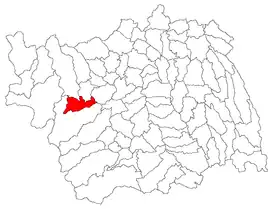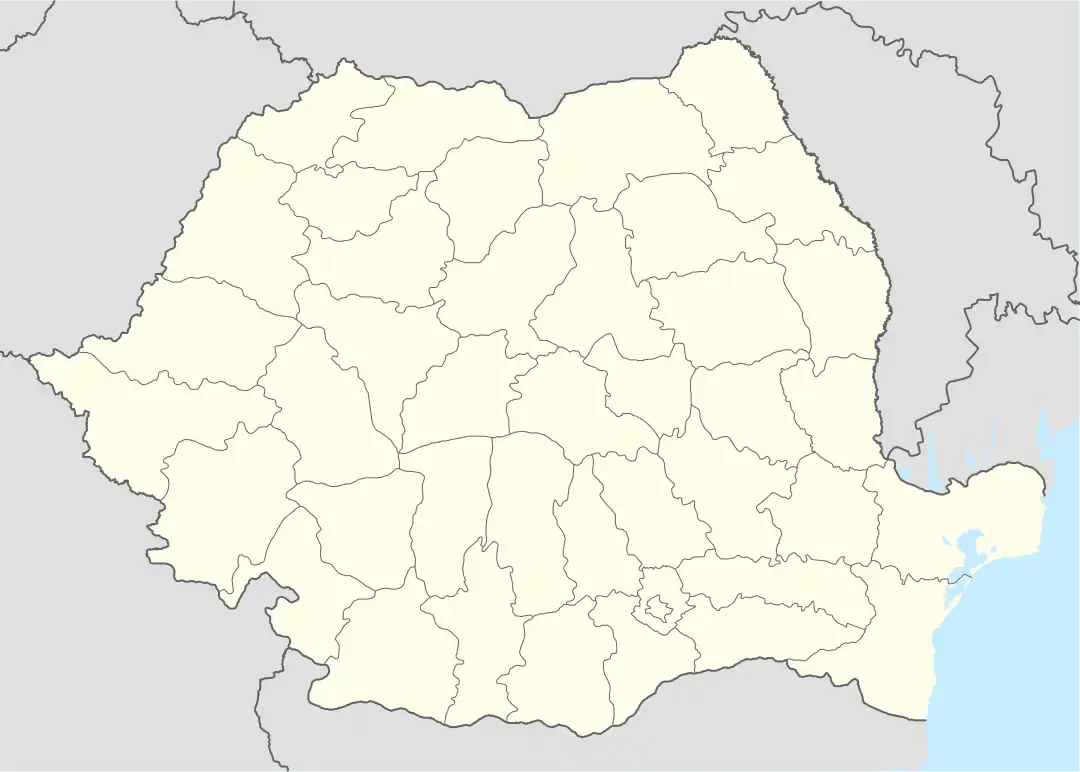Comănești | |
|---|---|
 | |
 Location in Bacău County | |
 Comănești Location in Romania | |
| Coordinates: 46°25′47″N 26°27′0″E / 46.42972°N 26.45000°E | |
| Country | Romania |
| County | Bacău |
| Government | |
| • Mayor (2020–2024) | Viorel Miron[1] (PNL) |
| Area | 63.87 km2 (24.66 sq mi) |
| Elevation | 400 m (1,300 ft) |
| Population (2021-12-01)[2] | 19,996 |
| • Density | 310/km2 (810/sq mi) |
| Time zone | EET/EEST (UTC+2/+3) |
| Postal code | 605200 |
| Area code | (+40) 02 34 |
| Vehicle reg. | BC |
| Website | www |

Comănești (Romanian pronunciation: [koməˈneʃtʲ]; Hungarian: Kománfalva) is a town in Bacău County, Western Moldavia, Romania, with a population of 19,996 as of 2021. It is situated on the river Trotuș, which flows between the Ciuc and the Tarcău mountains; 10 km (6 mi) of the course of the river pass through Comănești.
The town administers two villages, Podei and Vermești.
History
The area of the town of Comănești has been inhabited since the Neolithic period - Neolithic remains were found in the Vermești area of the town. The name is derived from the Cumans who once ruled the region. Its first written record dates from 1657, and its first presence on a map from the 1696 Sanson Map.
From the late 18th century onwards, the town was in the domain of the Ghica family of boyars, who remained an important presence in the area until the middle of the 20th century. The Ghica Palace (now housing the local museum), the park in front of the museum, and the railway stations are testimonies to their presence in the town.
During the summers of 2004, 2005, and 2006, Comănești suffered severe flooding of the Trotuș. Some specialists have associated those floods with the deforestation in the area. In 2006 and 2008, Comănești was the site of large explosion-like sounds that were not identified.
| Year | Pop. | ±% |
|---|---|---|
| 1956 | 12,392 | — |
| 1966 | 14,653 | +18.2% |
| 1977 | 16,879 | +15.2% |
| 1992 | 25,020 | +48.2% |
| 2002 | 26,237 | +4.9% |
| 2011 | 19,568 | −25.4% |
| 2021 | 19,996 | +2.2% |
| Source: Census data | ||
Industry
As of 2003, Comănești had an unemployment rate of 18.1%, much higher than the country's average, and the town was declared an underdeveloped region.
The town is in the center of a large coal field and there are also smaller amounts of oil in the area. The coal mine, which in 1989 employed 5,000 people, was finally closed down in 2005, leaving the last group of miners (260 in all) unemployed. The other major industry of the town is forestry, but the large lumberyard and factory were also closed; this area of enterprise is now dominated by small local businesses, but in the last few years some international investors started to appear in the city, especially in retail and commerce.
There have been new initiatives in recent months to attract investment into the area in both the industrial and tourism sectors.
Train station

The Comănești train station was built in 1899, modeled on the Lausanne and Curtea de Argeș railway stations.[3] The design was done by the Italian architect Giulio Magni, while the construction was done by the engineer Elie Radu.[4]
See also
References
- ↑ "Results of the 2020 local elections". Central Electoral Bureau. Retrieved 8 June 2021.
- ↑ "Populaţia rezidentă după grupa de vârstă, pe județe și municipii, orașe, comune, la 1 decembrie 2021" (XLS). National Institute of Statistics.
- ↑ Merticariu, Mircea (April 2, 2014). "Gara din Comănești, realizată în timpul lui Dimitrie N. Ghika, după modelul Gării Lausanne din Elveția". Adevărul (in Romanian). Retrieved December 27, 2020.
- ↑ Stan, Mădălina; Aurică, Emilia (2014), "Inginerul Elie Radu și drumul de fier de pe Valea Trotușului" (PDF), Columna Comănești (in Romanian), 3: 441–453, archived from the original (PDF) on 2018-12-09, retrieved 2020-12-27
External links
- (in Romanian) Official website Archived 2019-09-07 at the Wayback Machine
- (in Romanian) City Hall Official website
